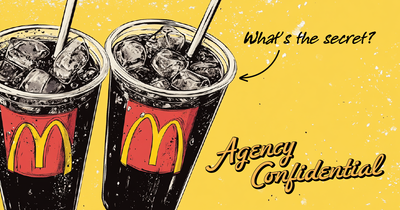Same Service DNA: Why Running an Agency is Like Running a Restaurant

When it comes to starting and running a creative agency, a mental model I use is to think about it like running a restaurant. Just on "easy" mode–you don't have the same fixed expenses (rent, electricity, gas, water, linens, maintenance, insurance, license fees, trash removal, etc.) or highly perishable inventory of assets. But depending on how you want to run yours, you may also be afflicted by the same insane drive for perfection, impossible standards, and constant pressure to deliver excellence while somehow keeping the lights on and your people sane.
Not all restaurants or agencies are like that, of course. But a service business is a service business, whether you're French Laundry or Pentagram.
Let me walk you through some agency/restaurant models:
First, you’ve got your fast food operators – the productized agencies. They’ve got their systems down cold. The customers prefer the affordability and ease of ordering, even if they don't get all the nutritional value. Sometimes, you just need ads to test with. It’s not haute cuisine, but it works. These guys are making money hand over fist while the rest of us struggle with our precious creative processes.
Then there’s your fast casual spots – the Sweetgreens and Chipotles of our industry. They’ve figured out something most of us are too stubborn or too proud to admit: you can serve good food, at scale, without killing yourself. They’ve got their mise en place figured out, their assembly lines humming. They’re not trying to reinvent the wheel with every order. Clients get to choose and they'll pay double for extra meat.
You've also got fine dining establishments, which feel closer to boutiques. High-touch service, signature style, premium pricing. Perhaps, there is even a dream of a Michelin star or bib gourmand!
I could go on and on with these analogies. Ghost kitchens, white label agencies, food trucks, yadda yadda.
More importantly, I think a lot of ambitious creatives find themselves not actually running a business with a systematic engine outputting creative on time and with decent service industry margins (30%?). And many restaurants, especially those run by talented chefs, also struggle to operate profitably.
What's that joke again?
How do you make a million in the restaurant business? Start with 2 million.
Now, I can't say I would know how to run a profitable food service business. But analogizing the work we do at our agency to running a tight restaurant operation has really helped refine our processes. Perhaps because plates are a bit more tangible than pixels.
There's a lot of learn through the theory of a well-run restaurant. To dump a few more parallels to really accentuate the similar service DNA:
Mise en Place
In professional kitchens, mise en place ("everything in its place") isn't just about organizing – it's a philosophy that enables both volume and excellence. Here's how it translates to agency work:
Restaurant Mise en Place
- Prep lists created night before
- Ingredients chopped, portioned, and stationed
- Sauces pre-made and ready
- Tools cleaned and positioned
- Stations set up for maximum efficiency
Agency Mise en Place
- Project templates and frameworks ready
- Common client requests pre-solved
- Design systems established
- Code libraries maintained
- Research and references organized
- Team capacity pre-allocated
Front of House vs. Back of House
Front of House: Client Service & Sales
In restaurants, the front of house staff manages the entire customer experience. They're the first impression, order-takers, experience-managers, and problem-solvers. In agencies, this translates to:
- Account managers = Servers
- Sales team = Hosts
- Project managers = Floor managers
- Client meetings = Table service
The parallels go deeper than titles. Both require:
- Reading the client/customer
- Managing expectations
- Timing delivery
- Handling complaints
- Upselling appropriately
- Maintaining the atmosphere
Back of House: Production & Operations
The kitchen is where the magic happens – in both cases:
- Creative teams = Line cooks
- Technical specialists = Prep cooks
- Creative director = Head chef
- Production manager = Sous chef
- Quality assurance = Expeditor
- Operations team = Kitchen porters
Both environments share:
- High-pressure production environments
- Need for precise timing and coordination
- Quality control systems
- Resource management
- Equipment and tool maintenance
- Standard operating procedures
The Service Cycle
There are some key differences between most agencies and restaurants. For example, they approach volume. Restaurants design their service cycle to handle dozens of simultaneous customers at different stages. Some agencies treat each client as a unique case (or they may be more of the fast-food model).
Regardless, the workflow similarities are striking:
- Initial Contact
- Restaurant: Guests arrive, are greeted, seated
- Agency: Prospects inquire, are qualified, scope discussed
- Order Taking
- Restaurant: Server explains menu, takes order, communicates special requests
- Agency: Requirements gathering, proposal writing, contract negotiation
- Production
- Restaurant: Kitchen prepares dishes according to tickets
- Agency: Team produces deliverables according to scope
- Quality Control
- Restaurant: Expeditor checks dishes before serving
- Agency: Internal review process before client presentation
- Delivery
- Restaurant: Food served, check-ins for satisfaction
- Agency: Deliverable presentation, feedback rounds
- Payment
- Restaurant: Bill presented, payment processed
- Agency: Final invoice sent, payment collected
There's more that I'll explore in other posts, I think you probably get the point. Run your services like you're Carmy from the Bear (without the interpersonal or mental health issues) and you're probably operating a pretty tight ship.
Whether you're running a restaurant or an agency, the secret ingredient isn't just what you serve – it's how you serve it at scale. Even if you're a boutique, this kind of systematic thinking is still incredibly helpful to wrap your head around.
For what it's worth, it does make me wonder if the best types of agencies are actually fast-casuals. The client selects from a few pre-ordained combinations of a "Core Or More" pricing model and the agency runs it down the assembly line with your selection. To be honest, I think, even for boutiques where they craft their service model to fit the client more, having a set of productized services (or their version of a Chipotle bowl) might save a lot of headache.

Regardless, the DNA of great service businesses seems to remain remarkably consistent across industries. Understanding these parallels helps us build better, more resilient service businesses for the future.
Now, if you’ll excuse me, I’ve got services to prep for.
P.S. What's even more fundamentally true, a great litmus test for a good or bad client is whether or not they are shitty to the "wait staff".




Member discussion